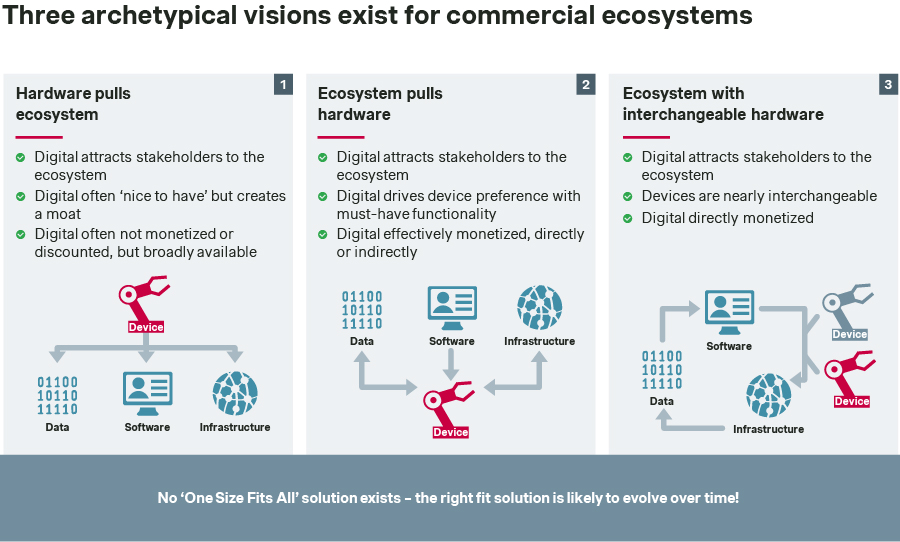The medtech sector is in the midst of a digital transformation. New digital solutions — ranging from software platforms to AI-powered diagnostics — are reshaping how medical devices and healthcare services operate. Despite the promise, digital monetization in healthcare has been inconsistent, with many medtech companies struggling to turn innovative digital offerings into sustainable revenue streams.
The digital monetization challenge in the medtech sector is compounded by the complexities of aligning new technologies with traditional healthcare business models. We explore why medtech digital monetization presents unique challenges and outline pragmatic approaches that companies can take to release the full potential of their digital assets.
The digital monetization problem in healthcare
Healthcare has been slow to benefit from the digital revolution that has transformed other industries. While healthcare companies have recognized the potential of digital technologies, the returns have often fallen short of expectations. For instance, in recent years, digital health funding has surged, driven by venture capital and private equity investments. The U.S. digital health sector logged USD 2.4 billion in venture funding in Q3 2024. However, tangible returns remain elusive, and valuations have fluctuated significantly.
One of the core issues contributing to this gap is a lack of effective monetization models. In many cases, healthcare companies view digital offerings as “nice-to-have” additions to their core products rather than independent value drivers. As a result, digital initiatives often lack the strategic vision and monetization focus required to generate sustainable growth.
Top considerations for monetizing digital innovation in medtech
1. Setting a strategic vision for digital ecosystems
The first step in effectively monetizing digital innovation is establishing a strategic vision for how digital solutions fit within the broader business ecosystem. A successful digital strategy must begin with a clear end-goal in mind: how does the digital offering enhance or complement the existing product portfolio?
Medtech companies should determine whether digital solutions are primarily aimed at attracting stakeholders to a broader ecosystem, creating an entry barrier, or driving direct revenue.

For example, a next generation sequencing company (Company A) primarily generates revenue through the sale of its DNA sequencing instruments and the associated consumables required for genomic analysis, while also offering software solutions and services that support genomic research and clinical applications. The company's software ecosystem demonstrates how digital tools can enhance hardware by offering cloud-based data analytics and software licensing. This approach not only enhances the value of the Company A's DNA sequencing devices but also provides a clear, multi-dimensional monetization model that contributes to the company’s overall profitability.
Developing a similar strategic vision — whether digital solutions act as an ecosystem pull or as a core value driver — is essential for medtech companies aiming to capture the full economic value of their innovations.
2. Driving adoption and trial with a ‘land’ pathway
Once a strategic vision is established, it is essential to drive adoption through a “land” pathway. This means overcoming barriers to initial adoption by making it as easy as possible for customers to trial new digital products, which is particularly significant in the capital-intensive medtech space. A “land and expand” strategy — commonly employed by SaaS companies — is now proving effective in medtech, leveraging the flexibility and scalability unique to digital solutions.
The “land and expand” approach starts with a low-risk trial, allowing customers to experience the benefits of a digital solution without major upfront commitments. For example, offering limited-time trials, freemium models, or usage-based pricing encourages healthcare providers to experiment with a new digital solution and assess its impact before committing fully. Importantly, pricing should be simple, easy to understand, and designed to minimize perceived risk. This is especially relevant in healthcare, where stakeholders are often hesitant to adopt new technologies due to regulatory concerns and cost constraints.
Publicly listed companies that employ a product-led growth (PLG) approach — where the product itself drives customer acquisition and engagement — demonstrate stronger growth and higher customer retention rates. In the medtech sector, employing a similar PLG strategy could not only help convert trials into long-term customers, but also create synergies with the traditionally high-touch sales process. This approach showcases confidence in the product’s value, facilitating deeper engagement and trust, and aligns well with the long-term sales relationships, often essential in healthcare. Moreover, a PLG strategy can streamline, adoption, especially for digital tools that integrate with existing healthcare infrastructure, reinforcing commitment and satisfaction over time.
3. Viewing monetization sources comprehensively
Medtech companies must adopt a more comprehensive view of digital monetization sources. Often, companies limit themselves to end-user payments (typically hospitals or healthcare providers) without exploring other potential monetization avenues. However, the digital monetization iceberg goes much deeper, with end-user payments being merely the tip.
Again, consider the example of Company A, which uses multiple monetization sources for its software ecosystem: software licensing, pull-through sales of hardware, and a two-sided marketplace model where both end users and developers are charged for access and usage. This multi-pronged approach allows the company to capture revenue from various parts of the ecosystem, including infrastructure partners like AWS, who share revenue for data hosting and analytics.
Medtech companies should consider similar opportunities to monetize digital products comprehensively, including partnerships with software developers, licensing agreements with hardware manufacturers, and collaborations with healthcare societies for training programs. Viewing monetization beyond the tip of the iceberg can reveal new revenue streams that support sustainable growth.
4. Creating a win-win monetization model
One of the key elements in driving sustainable growth is the development of win-win digital monetization models that align the success of the medtech company with that of its customers. In a win-win model, both parties benefit: as the customer succeeds, the company’s revenue grows.
An example of this model is the use of consumption-based pricing, where customers pay based on the actual usage of a digital solution. In healthcare, this can be highly effective, especially when pricing is aligned with clinical outcomes or efficiency gains. For instance, a cloud-based imaging platform could charge hospitals based on the number of scans analyzed, providing an incentive for hospitals to use the platform more frequently. Similarly, a remote monitoring solution could charge based on the number of patients actively monitored, ensuring that the cost aligns with the value delivered.
By aligning pricing with outcomes, medtech companies can enhance customer satisfaction and loyalty, as customers see direct value from their investments. This model also creates a natural pathway for expansion, as customers derive more value and scale up their use of the solution.
Embrace the right strategy for digital monetization to drive growth
Digital monetization is complex, but with the right strategic approach, it can become a major driver of growth and shareholder value. Medtech companies that succeed in monetizing digital assets do more than just create new products — they build ecosystems that deliver tangible value, foster customer loyalty, and drive sustainable growth.
As digital continues to transform healthcare, those who can effectively navigate the monetization landscape will be best positioned to lead the next era of innovation. Our experts specialize in creating forward-thinking strategies and resilient operating models tailored for the medtech and diagnostics sector.
Discover how we can assist in creating sustainable digital-first products for your commercial growth. Contact us today.




